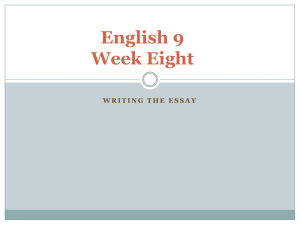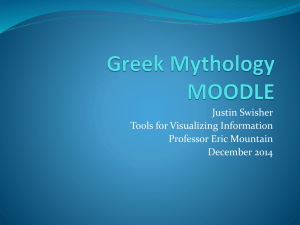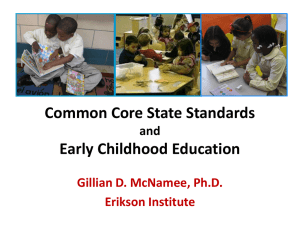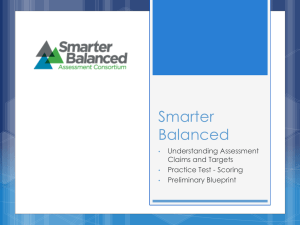Elementary Workshop
advertisement
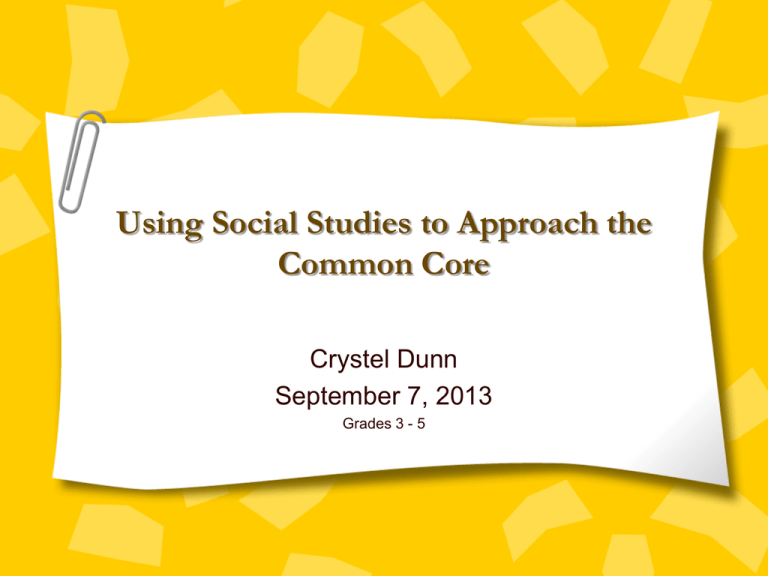
Using Social Studies to Approach the Common Core Crystel Dunn September 7, 2013 Grades 3 - 5 Why Use Primary Sources http://www.history.com/videos/what-was-in-lincolns-pockets#what-was-in-lincolns-pockets Social Studies Course Descriptions for 3 - 5 Third Grade: North America and the Caribbean - The third grade social studies curriculum consists of the following content area strands: American History, Geography, Economics, and Civics. Third grade students will learn about North America and the Caribbean. They will focus on the regions of the United States, Canada, Mexico, and the Caribbean Islands. Their study will include physical and cultural characteristics as they learn about our country and its neighbors. Fourth Grade: Florida Studies – The fourth grade social studies curriculum consists of the following content area strands: American History, Geography, Economics and Civics. Fourth grade students will learn about Florida history focusing on exploration and colonization, growth, and the 20th Century and beyond. Students will study the important people, places, and events that helped shape Florida history. Fifth Grade: United States History – The fifth grade social studies curriculum consists of the following content area strands: American History, Geography, Economics, and Civics. Fifth grade students will study the development of our nation with emphasis on the people, places, and events up to approximately 1850. Students will be exposed to the historical, geographic, political, economic, and sociological events which influenced the initial inhabitation, exploration, colonization, and early national periods of American history. So that students can clearly see the relationship between cause and effect in history, students should also have the opportunity to explore how individuals and events of this period influenced later events in the development of our nation. Department of Social Sciences Website socialsciences.dadeschools.net Click on Pacing Guides/Lessons Pacing Guides / Year at a Glance /Civics Integration http://socialsciences.dadeschools.net/pacingguides.asp Click to access pacing guides for each nineweek grading period and Year at a Glance (for major topics) Lesson plans that are tied to tested Benchmarks, complete with assessments, can be accessed two ways: (1) through the Pacing Guides or (2) by clicking on the lesson plan link directly. Civic Integration Lesson Plans http://socialsciences.dadeschools.net/pacingguides.asp Lesson Plans Include: – – – – Essential Questions Lesson Materials Standards Guided/Independent Activities – Formative and Summative Assessments – Technology Integration – Differentiated Instruction Strategies Civics Integration Lesson Plans Topics Include: – 3.C.1.1. Purpose and Need for Government – 3.C.1.2. Government-Power from the People – 4.C.2.2. Making Laws in Florida – 4.C.2.3. Citizen’s Rights and Responsibilities – 5.C.1.2. What is a Constitution? – 5.C.3.4. The Amendment Process What are Common Core State Standards? “The Common Core State Standards provide a consistent, clear understanding of what students are expected to learn, so teachers and parents know what they need to do to help them.” Source: corestandards.org The Common Core State Standards identify the skills students need to have to move forward. Teachers will decide the best way to teach their students in order for them to meet Common Core expectations Reading Common Core State Standards CCSS.ELA-Literacy.RI.3.1 Common Core State Standard Strand (English Language Arts-Literacy Reading I. T.) Grade Level Standard Ask and answer questions to demonstrate understanding of a text, referring explicitly to the text as the basis for the answers. English Language Arts Standards » Standard 10:Range of Text Types (Grades K-5) Source: corestandards.org Literature Informational Text Stories Dramas Poetry Literary Nonfiction and Historical, Scientific, and Technical Texts Includes children’s adventure stories, folktales, legends, fables, fantasy, realistic fiction, and myth Includes staged dialogue and brief familiar scenes Includes nursery rhymes and the subgenres of the narrative poem, limerick, and free verse poem Includes biographies and autobiographies; books about history, social studies, science, and the arts; technical texts, including directions, forms, and information displayed in graphs, charts, or maps; and digital sources on a range of topics Grade 3 English Language Arts Standards » Speaking & Listening » Grade 3 Standards in this strand: Comprehension and Collaboration CCSS.ELA-Literacy.SL.3.1 Engage effectively in a range of collaborative discussions (one-on-one, in groups, and teacher-led) with diverse partners on grade 3 topics and texts, building on others’ ideas and expressing their own clearly. – – – – CCSS.ELA-Literacy.SL.3.1a Come to discussions prepared, having read or studied required material; explicitly draw on that preparation and other information known about the topic to explore ideas under discussion. CCSS.ELA-Literacy.SL.3.1b Follow agreed-upon rules for discussions (e.g., gaining the floor in respectful ways, listening to others with care, speaking one at a time about the topics and texts under discussion). CCSS.ELA-Literacy.SL.3.1c Ask questions to check understanding of information presented, stay on topic, and link their comments to the remarks of others. CCSS.ELA-Literacy.SL.3.1d Explain their own ideas and understanding in light of the discussion. CCSS.ELA-Literacy.SL.3.2 Determine the main ideas and supporting details of a text read aloud or information presented in diverse media and formats, including visually, quantitatively, and orally. CCSS.ELA-Literacy.SL.3.3 Ask and answer questions about information from a speaker, offering appropriate elaboration and detail Presentation of Knowledge and Ideas CCSS.ELA-Literacy.SL.3.4 Report on a topic or text, tell a story, or recount an experience with appropriate facts and relevant, descriptive details, speaking clearly at an understandable pace. CCSS.ELA-Literacy.SL.3.5 Create engaging audio recordings of stories or poems that demonstrate fluid reading at an understandable pace; add visual displays when appropriate to emphasize or enhance certain facts or details. CCSS.ELA-Literacy.SL.3.6 Speak in complete sentences when appropriate to task and situation in order to provide requested detail or clarification. (See grade 3 Language standards 1 and 3 here for specific expectations.) “How will I teach CCSS and Social Studies together?” NGSSS-SS SS.3.C.1.3: Explain how government was established through a written Constitution. SS.3.A.1.1: Analyze primary and secondary sources. Title: Explain How Government Was Established Through a Written Constitution Social Studies Lesson Plan: SS.3.C.1.3 Essential Question: – How was the United States’ government established through a written Constitution? Common Core/Social Studies Connections America Gets a Constitution: http://www.history.com/topics/constitut ion/videos#america-gets-aconstitution Class Reading Attachment B- What is a Constitution? Model paraphrasing with students Have students read and take notes from this document with a partner Have students record their findings and share with the class Preamble to the United States Constitution Identify/Define Key Terms and Phrases: Preamble Tranquility Welfare Posterity Ordain "We the People of the United States, in Order to form a more perfect Union, establish Justice, insure domestic Tranquility, provide for the common defence, promote the general Welfare, and secure the Blessings of Liberty to ourselves and our Posterity, do ordain and establish this Constitution for the United States of America." Identifying Evidence in Historic Photographs Allow students to examine primary sources themselves Allow students to share their findings. Provide students with immediate feedback Analysis Activity Image 1 Source: www.loc.gov/teachers/classroommaterials/primarysourcesets/constitution/pdf/foundation.pdf Essential Question How was the United States’ government established through a written Constitution? Grade 4 Effects of Florida land boom and bust Florida during the Great Depression English Language Arts Standards » Reading: Informational Text » Grade 4 Standards in This Strand: Key Ideas and Details CCSS.ELA-Literacy.RI.1.1 Ask and answer questions about key details in a text. CCSS.ELA-Literacy.RI.1.2 Identify the main topic and retell key details of a text. CCSS.ELA-Literacy.RI.1.3 Describe the connection between two individuals, events, ideas, or pieces of information in a text. Craft and Structure CCSS.ELA-Literacy.RI.1.4 Ask and answer questions to help determine or clarify the meaning of words and phrases in a text. CCSS.ELA-Literacy.RI.1.5 Know and use various text features (e.g., headings, tables of contents, glossaries, electronic menus, icons) to locate key facts or information in a text. CCSS.ELA-Literacy.RI.1.6 Distinguish between information provided by pictures or other illustrations and information provided by the words in a text. Integration of Knowledge and Ideas CCSS.ELA-Literacy.RI.1.7 Use the illustrations and details in a text to describe its key ideas. CCSS.ELA-Literacy.RI.1.8 Identify the reasons an author gives to support points in a text. CCSS.ELA-Literacy.RI.1.9 Identify basic similarities in and differences between two texts on the same topic (e.g., in illustrations, descriptions, or procedures CCSS.ELA-Literacy.SL.K.3 -Ask and answer questions in order to seek help, get information, or clarify something that is not understood. Range of Reading and Level of Text Complexity CCSS.ELA-Literacy.RI.1.10 With prompting and support, read informational texts appropriately complex for grade 1 NGSSS-SS Grade 4 SS.4.A.7.1 Describe the causes and effects of the 1920's Florida land boom and bust. SS.4.A.7.2 Summarize challenges Floridians faced during the Great Depression. SS.4.A.6.3 Describe the contributions of significant individuals to Florida (Carl Fisher, Thomas Edison, Eddie Rickenbacker, Dr. John Gorrie, Willis Carrier, Edwin L. Moore, Cedric Donald Atkins, Luis Gardner MacDowell, Zora Neale Hurston) SS.4.A.9.1 Utilize timelines to sequence key events in Florida history. SS.4.A.1.1 Analyze primary and secondary resources to identify significant individuals and events throughout Florida history. SS.4.A.1.2 Synthesize information related to Florida history through print and electronic media. Grade 4 Informational Text Sample http://www.miamiherald.com/2012/11/27/3115540/the-worst-year-for-south-florida.html How were cities in Florida Marketed? Common Core/Social Studies Connections Sample Performance Tasks for Teaching Informational Text include: – – Students determine the meaning of domain-specific words or phrases like economy, or The Great Depression. Students should be able to identify the relationship between the economy and unemployment. Miami Vacation Ad, 1920’s Grade 5 English Language Arts Standards » Reading: Informational Text » Grade 5 Standards in this strand: CCSS.ELA-Literacy.RI.5.1 CCSS.ELA-Literacy.RI.5.2 CCSS.ELA-Literacy.RI.5.3 CCSS.ELA-Literacy.RI.5.4 CCSS.ELA-Literacy.RI.5.5 CCSS.ELA-Literacy.RI.5.6 CCSS.ELA-Literacy.RI.5.7 CCSS.ELA-Literacy.RI.5.8 CCSS.ELA-Literacy.RI.5.9 CCSS.ELA-Literacy.RI.5.10 Key Ideas and Details CCSS.ELA-Literacy.RI.5.1 Quote accurately from a text when explaining what the text says explicitly and when drawing inferences from the text. CCSS.ELA-Literacy.RI.5.2 Determine two or more main ideas of a text and explain how they are supported by key details; summarize the text. CCSS.ELA-Literacy.RI.5.3 Explain the relationships or interactions between two or more individuals, events, ideas, or concepts in a historical, scientific, or technical text based on specific information in the text. Craft and Structure CCSS.ELA-Literacy.RI.5.4 Determine the meaning of general academic and domain-specific words and phrases in a text relevant to a grade 5 topic or subject area. CCSS.ELA-Literacy.RI.5.5 Compare and contrast the overall structure (e.g., chronology, comparison, cause/effect, problem/solution) of events, ideas, concepts, or information in two or more texts. CCSS.ELA-Literacy.RI.5.6 Analyze multiple accounts of the same event or topic, noting important similarities and differences in the point of view they represent. Integration of Knowledge and Ideas CCSS.ELA-Literacy.RI.5.7 Draw on information from multiple print or digital sources, demonstrating the ability to locate an answer to a question quickly or to solve a problem efficiently. CCSS.ELA-Literacy.RI.5.8 Explain how an author uses reasons and evidence to support particular points in a text, identifying which reasons and evidence support which point(s). CCSS.ELA-Literacy.RI.5.9 Integrate information from several texts on the same topic in order to write or speak about the subject knowledgeably. Range of Reading and Level of Text Complexity CCSS.ELA-Literacy.RI.5.10 By the end of the year, read and comprehend informational texts, including history/social studies, science, and technical texts, at the high end of the grades 4–5 text complexity band independently and proficiently. English Language Arts Standards » Writing » Grade 5 CCSS.ELA-Literacy.W.5.7: Conduct short research projects that use several sources to build knowledge through investigation of different aspects of a topic. CCSS.ELA-Literacy.W.5.8: Recall relevant information from experiences or gather relevant information from print and digital sources; summarize or paraphrase information in notes and finished work, and provide a list of sources. NGSSS-SS SS.5.A.1.1: Use primary and secondary sources to understand history. SS.5.A.6.6: Explain how westward expansion affected Native Americans. Closing Activity Informational Text Analysis: – Native American Assimilation – Describe the impact of immigrants on Native Americans – Map skills Apache Teenagers in Carlisle, Pennsylvania (1887) Image 1 Source: http://docsteach.org/activities/11878/print Image 2 Source: http://docsteach.org/documents/593352/detail?menu=closed&mode=search&sortBy=relevance&q=documentpairs&commit=Go Image 3 Source: http://www.enchantedlearning.com/usa/states/florida/ Image 4 Source: http://www.carlisle.army.mil/usawc/dmspo/JTSD/AY11/DrivingDirections/DrivingDirections.htm Analyzing Informational Text: The School Days of an Indian Girl II. The Cutting of My Long Hair Photo of Zitkala Sa, (Gertrude Bonnin) Source: Library of Congress Photo used with permission of University of South Dakota E. DeLoria Collection http://www.loc.gov/teachers/classroommaterials/lessons/indianschools/journal .html “How will I teach CCSS and Social Studies together?” Closing Thoughts Establish a learner-centered environment Increase student inquiry/communication skills Encourage student self-assessment of process and content knowledge Session 1: Follow-up Assignment Consider the resources from today’s workshop and create a lesson plan for your class that includes the following elements: – Next Generation Sunshine State Standards for Social Studies – Common Core Standards – 2 Primary or Secondary Sources – 1 Informational Text Sample (i.e., story, drama, poetry, literary non-fiction or historical text)
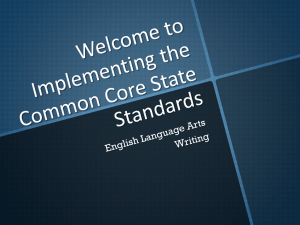
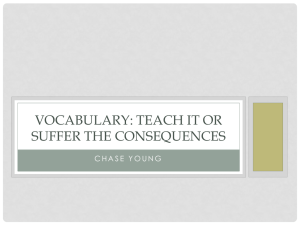
![iPads_and_Writing_2013[1]](http://s2.studylib.net/store/data/005383991_1-1bc8c0f2382c2ccb89e094c534f531f0-300x300.png)
